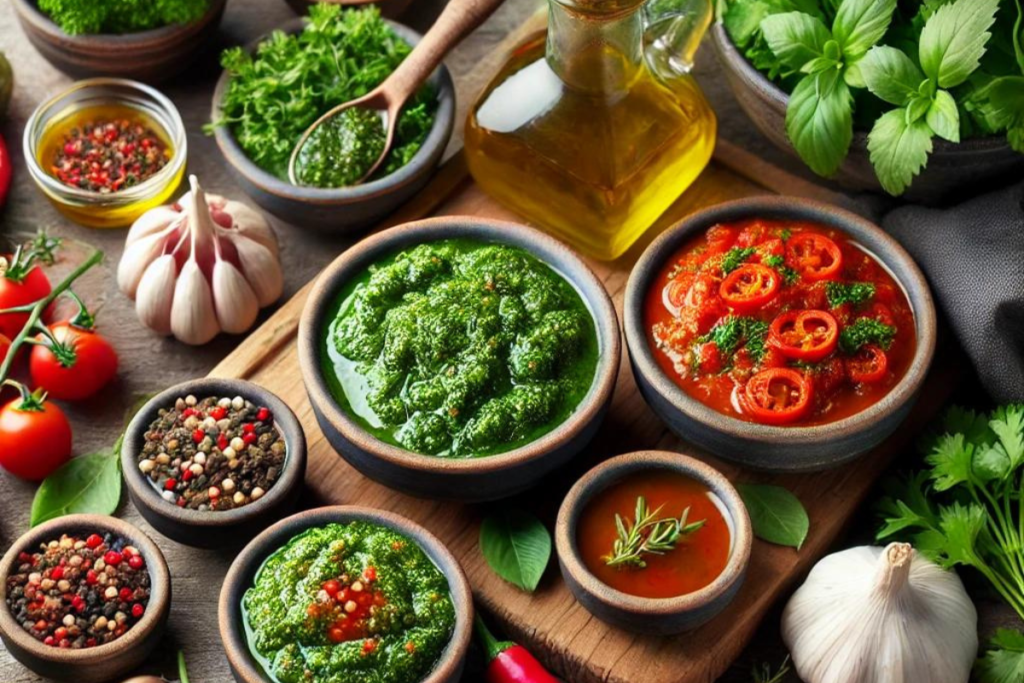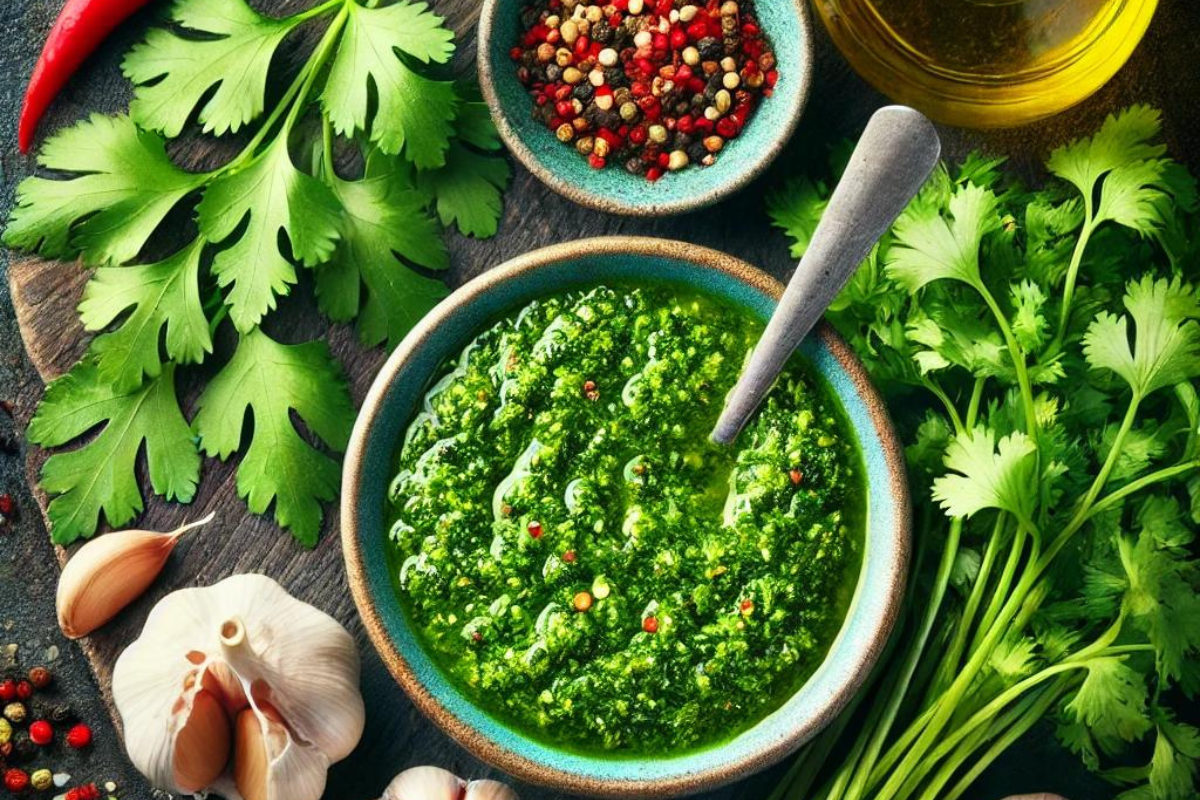Chimichurri sauce is a bright and herb-filled condiment from Argentina and Uruguay. Known for its bold flavors, it blends fresh herbs, garlic, olive oil, and vinegar. Typically, people serve it with grilled meats, but you can also enjoy it on seafood, vegetables, and even salads.
Since this sauce is straightforward to make and adjust, many home cooks love it. In this article, I’ll explain the key ingredients, explore variations, and show how to use chimichurri in various dishes.
Main Ingredients of Chimichurri Sauce

Chimichurri uses simple ingredients that blend to create a fresh and bold flavor. These ingredients are widely available and can enhance many dishes:
- Fresh herbs: Most often, people use parsley and cilantro as the base, which gives the sauce its green color and earthy taste.
- Garlic: This ingredient adds a sharp bite that balances the freshness of the herbs.
- Olive oil: It helps bind the ingredients, creating a smooth texture.
- Red wine vinegar: The vinegar provides tanginess and also preserves the herbs.
- Red pepper flakes offer a touch of heat, which you can adjust depending on your spice preference.
If you want to keep your herbs fresh longer, check out these fresh herb preservation tips.
How to Make Chimichurri Sauce
Making chimichurri is not only quick but also straightforward. You don’t need to cook anything, so it’s an easy addition to any meal. Here’s how you can prepare it:
- Chop the garlic and herbs: First, finely chop parsley, cilantro, and garlic. If you prefer, you can use a food processor to speed up the process.
- Mix the ingredients: Place the herbs and garlic in a bowl after chopping. Gradually stir in the red wine vinegar and olive oil, blending until the mixture becomes smooth.
- Season to taste: Finally, add salt, pepper, and red pepper flakes. If the sauce is too thick, you can thin it with water.
If you like experimenting with flavors, explore these creative chimichurri recipe variations for a twist on the classic.
Variations of Chimichurri Sauce
One of the best things about chimichurri is its flexibility. You can easily customize it to suit your preferences by making minor adjustments. Here are a few popular variations:
- Red Chimichurri: Adding roasted red peppers or tomatoes can create a red version of the sauce. This variation gives the sauce a slightly sweeter and smokier flavor.
- Herb Swaps: Instead of using parsley and cilantro, try replacing them with herbs like oregano, mint, or basil for a different twist.
- Spicy Chimichurri: If you prefer more heat, add extra jalapeños or serrano peppers to increase the spice.
How to Use Chimichurri Sauce
Although chimichurri pairs beautifully with grilled meats, there are many other ways to enjoy it. Here are some creative options for using it in your meals:
- Grilled Meats: Chimichurri enhances the flavor of steak, pork, or chicken, adding a bright, fresh taste to these rich meats.
- Seafood: Drizzle chimichurri over grilled shrimp or salmon for a zesty kick that complements seafood.
- Vegetables: Toss roasted or grilled vegetables like zucchini or bell peppers with chimichurri to give them an extra layer of flavor.
- Salads: Chimichurri also works as a flavorful salad dressing, especially for grain salads or hearty greens like kale and spinach.
- Dipping Sauce: Serve chimichurri as a dipping sauce for bread or alongside roasted potatoes to create a simple but flavorful side.
Try this comforting chicken and sausage gumbo for a hearty dish that pairs well with chimichurri.
Nutritional Benefits of Chimichurri
Chimichurri not only adds flavor but also brings several health benefits. Its fresh ingredients offer a range of nutritional advantages:
- Parsley and Cilantro: Both herbs are rich in antioxidants, which help protect your cells and support heart health.
- Garlic: Known for its immune-boosting properties, garlic also helps reduce inflammation.
- Olive Oil: As a great source of healthy fats, olive oil promotes heart health and supports overall wellness.
Storing and Preserving Chimichurri
You can store chimichurri in the refrigerator for up to two weeks. The vinegar keeps the herbs fresh, and the olive oil helps maintain the sauce’s texture. If you need to store it for longer, freezing it in small portions—such as ice cubes—allows for easy use when needed.
FAQs About Chimichurri Sauce
Is Chimichurri Spicy?
Chimichurri has a mild heat from the red pepper flakes, but you can control the spiciness by adjusting the amount to your liking.
Can You Freeze Chimichurri Sauce?
Yes, you can freeze chimichurri, and freezing it in small portions ensures that you only thaw what you need, reducing waste.
What’s the Difference Between Chimichurri and Pesto?
While both sauces use fresh herbs, chimichurri has a tangy flavor from the vinegar. In contrast, pesto is creamier because it includes parmesan cheese and pine nuts.
Can Chimichurri Be Used as a Salad Dressing?
Absolutely! Chimichurri works wonderfully as a zesty salad dressing, especially for grain or hearty green salads.
Chimichurri is a simple yet flavorful sauce that can elevate various dishes. Whether using it as a marinade, dressing, or dipping sauce, chimichurri adds a fresh, zesty kick to any meal. If you’re ready to explore more ways to use this sauce, check out additional recipe ideas and bring chimichurri into your kitchen today!
